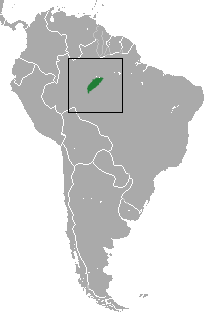| Chestnut-bellied titi | |
|---|---|
| Scientific classification | |
| Kingdom: | Animalia |
| Phylum: | Chordata |
| Class: | Mammalia |
| Order: | Primates |
| Suborder: | Haplorhini |
| Infraorder: | Simiiformes |
| Family: | Pitheciidae |
| Genus: | Plecturocebus |
| Species: | P. caligatus |
| Binomial name | |
| Plecturocebus caligatus (Wagner, 1842) | |
 | |
| Chestnut-bellied Titi range | |
| Synonyms | |
Callicebus caligatusWagner, 1842 | |
The chestnut-bellied titi monkey (Plecturocebus caligatus) is a species of titi monkey, a type of New World monkey, endemic to Brazil. It was originally described as Callicebus caligatus in 1842. [2]
